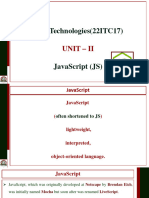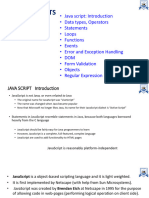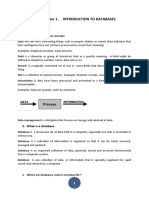0% found this document useful (0 votes)
15K views22 pagesJava Script: An Introduction
JavaScript was designed to add interactivity to HTML pages. It is a scripting language that is usually embedded directly into HTML and allows altering web pages in response to user actions. JavaScript is not Java - it was developed by Netscape, only runs in browsers, and is not a full programming language but has a similar syntax. JavaScript is an interpreted, loosely typed, object-based scripting language that is easy to learn and use for quick development of simple programs. It supports common data types, variables, operators, and can capture and validate user input through forms.
Uploaded by
1MS18CS146 Rahil M HariharCopyright
© © All Rights Reserved
We take content rights seriously. If you suspect this is your content, claim it here.
Available Formats
Download as PPT, PDF, TXT or read online on Scribd
0% found this document useful (0 votes)
15K views22 pagesJava Script: An Introduction
JavaScript was designed to add interactivity to HTML pages. It is a scripting language that is usually embedded directly into HTML and allows altering web pages in response to user actions. JavaScript is not Java - it was developed by Netscape, only runs in browsers, and is not a full programming language but has a similar syntax. JavaScript is an interpreted, loosely typed, object-based scripting language that is easy to learn and use for quick development of simple programs. It supports common data types, variables, operators, and can capture and validate user input through forms.
Uploaded by
1MS18CS146 Rahil M HariharCopyright
© © All Rights Reserved
We take content rights seriously. If you suspect this is your content, claim it here.
Available Formats
Download as PPT, PDF, TXT or read online on Scribd
/ 22
























































































